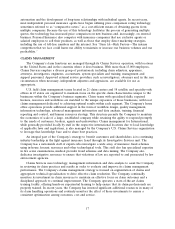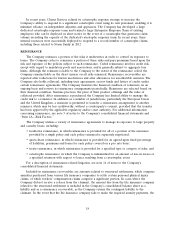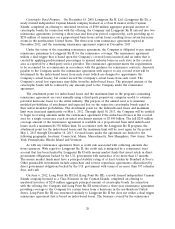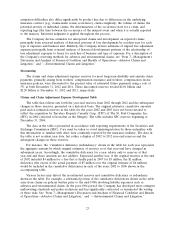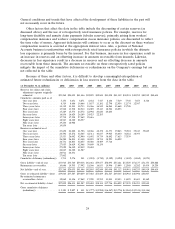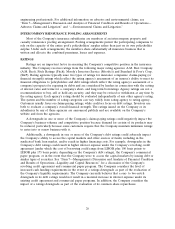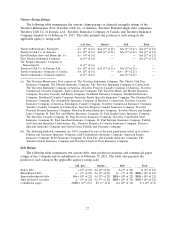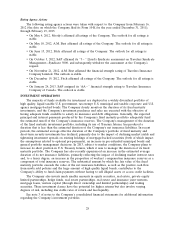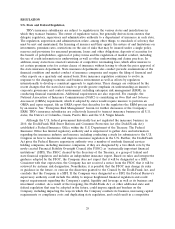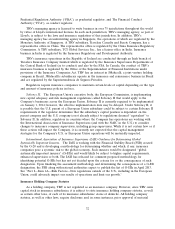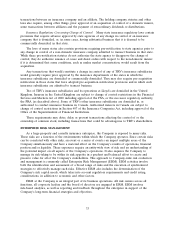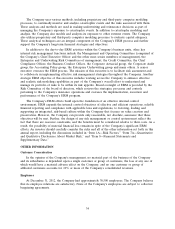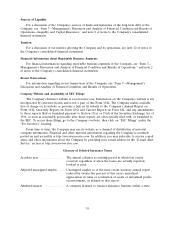Travelers 2012 Annual Report Download - page 37
Download and view the complete annual report
Please find page 37 of the 2012 Travelers annual report below. You can navigate through the pages in the report by either clicking on the pages listed below, or by using the keyword search tool below to find specific information within the annual report.
For years prior to 2004, the table excludes reserves of SPC, which were acquired in the Merger on
April 1, 2004. Accordingly, the reserve development (net reserves for claims and claim adjustment
expense re-estimated as of subsequent years less net reserves recorded at the end of the year, as
originally estimated) for years prior to 2004 relates only to losses recorded by TPC and does not
include reserve development recorded by SPC. For 2004 and subsequent years, the table includes SPC
reserves acquired and subsequent development recorded on those reserves. At December 31, 2004, SPC
gross reserves were $23,274 million, and net reserves were $15,959 million.
In December 2008, the Company completed the sale of Unionamerica Holdings Limited
(Unionamerica), which comprised its United Kingdom (U.K.)-based runoff insurance and reinsurance
businesses. (Unionamerica was acquired in 2004 as part of the Merger.) Immediately before the sale,
the claims and claim adjustment expense reserves of Unionamerica totaled $790 million. As a result of
the sale, those obligations ceased being the responsibility of the Company and its affiliates. The sale is
reflected in the table as a reduction in December 31, 2008 net reserves of $790 million and as a $790
million increase in paid losses for each of the years 2004 through 2007 to reflect the transfer (payment)
of the reserves to the buyer, resulting in no impact to incurred losses.
The gross and net cumulative deficiency (redundancy) by calendar year as set forth in the table
above includes the following impact of unfavorable prior year reserve development related to asbestos
and environmental claims and claim adjustment expenses, in millions:
Asbestos 2002 2003 2004 2005 2006 2007 2008 2009 2010 2011
Gross ........................ $1,728 $1,703 $1,913 $1,079 $882 $883 $813 $628 $366 $171
Net ......................... $1,604 $1,580 $1,732 $ 901 $745 $745 $675 $490 $350 $175
Environmental 2002 2003 2004 2005 2006 2007 2008 2009 2010 2011
Gross ........................ $ 807 $ 748 $ 701 $ 684 $576 $394 $309 $224 $179 $ 99
Net ......................... $ 760 $ 701 $ 691 $ 661 $541 $356 $271 $201 $166 $ 90
Reserves on Statutory Accounting Basis
At December 31, 2012, 2011 and 2010, claims and claim adjustment expense reserves (net of
reinsurance) shown in the preceding table, which are prepared in accordance with U.S. generally
accepted accounting principles (GAAP reserves), were $22 million lower, $20 million higher and $20
million higher, respectively, than those reported in the Company’s respective annual reports filed with
insurance regulators, which are prepared in accordance with statutory accounting practices (statutory
reserves).
The differences between GAAP and statutory reserves are primarily due to the differences in
GAAP and statutory accounting for two items, (1) fees associated with billing of required
reimbursements under large deductible business, and (2) the accounting for retroactive reinsurance. For
large deductible business, the Company pays the deductible portion of a casualty insurance claim and
then seeks reimbursement from the insured, plus a fee. This fee is reported as fee income for GAAP
reporting, but as an offset to claim expenses paid for statutory reporting. Retroactive reinsurance
balances result from reinsurance placed to cover losses on insured events occurring prior to the
inception of a reinsurance contract. For GAAP reporting, retroactive reinsurance balances are included
in reinsurance recoverables and result in lower net reserve amounts. Statutory accounting practices
require retroactive reinsurance balances to be recorded in other liabilities as contra-liabilities rather
than in loss reserves.
Asbestos and Environmental Claims
Asbestos and environmental claims are segregated from other claims and are handled separately by
the Company’s Special Liability Group, a separate unit staffed by dedicated legal, claim, finance and
25




